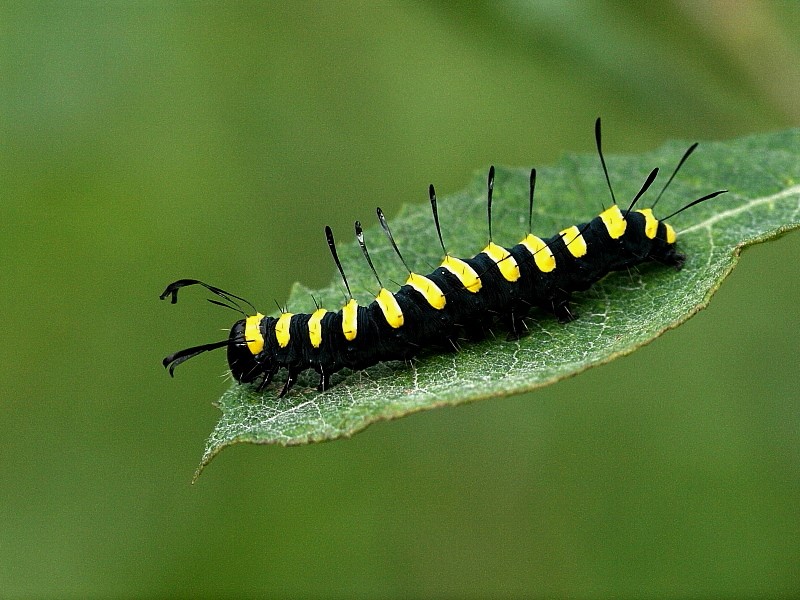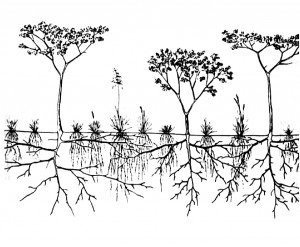
The Leaf And The Caterpillar, Slow Thinking On Sentient Life
Alder Groves Exchange Important Information Over Great Distance
They Communicate At Speeds Approaching The Human Nervous System
Thinking about the recent news of plankton blooms being shown to have sentient life behaviour I recalled another case of sentient life in plants. It came from my work on forest ecology where I was working with alder forests of the Pacific Northwest. A paper came out in a forest science journal from a research group in Washington State. They were studying Alder trees and chemical response and signalling.
They were conducting a series of experiments that came about when they developed an instrument they could place up against a living leaf on an alder tree. The instrument would sniff chemicals the leaf produced. They were especially interested in defensive chemicals that the alder leave produced when being fed upon by caterpillars. When the caterpillar bit on a leaf that leaf produced a caterpillar repellent.
They started on one leaf and had the instrument clock running. They held a caterpillar up to the leaf and as it began to chomp down on the leaf they would record the time it took for the repellent chemical to be produced. Simple and elegant.

This alder munching monster is know to all alder trees, word of it arrival is instantly passed amongst thousands of trees.
OK so the first test shows that they cannot see a time lag on the chemical production. It is produced at first bite. Almost like a flinch you or I might show if a mosquito the size of a crow bit us.
On to the next experiment. On a leaf on the same twig as the leaf to be bitten they placed the instrument. Flinch. The time for the leaf a few centimetres away from the first produced the chemical in the same time frame as the first test. Their instrument could not measure the time difference. On to leaves further and further away from the bitten leaf on the same tree. Still the flinch time remained constant.
 OK this is getting strange. Here comes some of the magic of Alder trees. They reproduce from seeds yes, but even more they reproduce from root suckers. Alder tree roots away from the tree trunk often sends up a shoot to the surface and from that shoot grows a new alder tree, a perfect clone of the first. They do this over and over until they become a grove of trees.
OK this is getting strange. Here comes some of the magic of Alder trees. They reproduce from seeds yes, but even more they reproduce from root suckers. Alder tree roots away from the tree trunk often sends up a shoot to the surface and from that shoot grows a new alder tree, a perfect clone of the first. They do this over and over until they become a grove of trees.
Moreover since they also grow from seeds trees that have grown from different seeds near one another they intermingle their root systems and when the roots touch they graft together under ground joining into one large super organism.
Thus when you come across a grove of Alders that covers very large areas, it might look like a forest of individual trees to you and I but in reality all of those trees are intimately joined at the root.
Back to the forest scientists and the caterpillars. So our scientists have not been able to resolve a time between caterpillar bite and leaf flinch on a single tree. Knowing that the trees are joined at the root they move the instrument over to the nearest tree. DANG IT… same result no resolvable time differential. OK one tree step further and further they go. Finally they start seeing the time lag they have been looking for. They have the distance and they have a time. And boy o boy is the speed fast at which the alders flinch when bitten.
They dutifully write up this wonderful and elegant bit of alder tree and caterpillar science and the paper is published. They are conservative government scientists so they write just the facts with no wild ideas. The science is just too good to cloud it with any strange hypotheses. They do note that the speed of the chemical signal sharing is very fast, and appears faster than known diffusive chemical processes.
I read the paper and see the time element and the faster than chemical diffusive process bit. WOW what is faster than chemistry in life. Of course that’s easy it is the signalling that moves in nervous systems. A quick internet search for such speed numbers and holy alder batman alders are flinching at 1/10th the speed of humans.
But wait Alders have no differentiated cells that resemble mammalian nerves. They can’t do that, the are just dumb vegetables, far down on the evolutionary ladder from US. Well at least they are only 1/10th our speed, that’s surely less evolved than US.
But then it comes to me since we are all alone and mobile, and full of delicious nutrition we have to be fast or we are eaten.
Trees on the other hand are rooted in place and have no chance to flee from caterpillars or anything else wanting to harm or change it. They need a different strategy for life. They need to be a distributed mesh network of life sharing who and what they are and their insights with their kin, and not by having mum and dad send them off to school to do so. Since they live for centuries and stay in one place the have no need or even concept of speed. What they need in terms of communication is merely “fast enough.” But they do need to be in a network, or rootwork, environment lest the be alone.
This works for them, trees, for the same reason you can get so much done with the tiny slow computer processor in your mobile phone in comparison to your honking tricked out full tilt ultra fast laptop or home gaming computer. Your tiny brained slow limited phone processor gives you access to the “rootwork” and the great Google collective brain in the blink of an eye, plenty fast to share all the information you could ever need. Texting by the way is about 1/10th the speed of speech.
You can talk to trees, the problem is getting them to notice you. A tree will notice you IF you sit quietly at its base for a week!
OK, here’s a great idea. We need an app for that. It will attach us to trees so we can carry on a normal txting conversation with them. Watch for it on your favourite crowd-sourcing platform
So what do you suppose Alder trees do for all the centuries that they stand in place next to their buds.
I’m sure our Alders have the equivalent to book clubs and internet chat rooms. There are probably Alder jerks who are incessant rootwork trolls constantly tossing out insults just to get another Alder to flinch.
Here’s s link to a wonderful posting about how trees are very much like us.
Read more about sentience in plankton blooms here…
Here’s a link to a discovery of nerve like features in seabed bacterial mats that interconnect the bacteria over kilometers…. read it here..
Want more here’s free living ocean bacteria doing the same…








